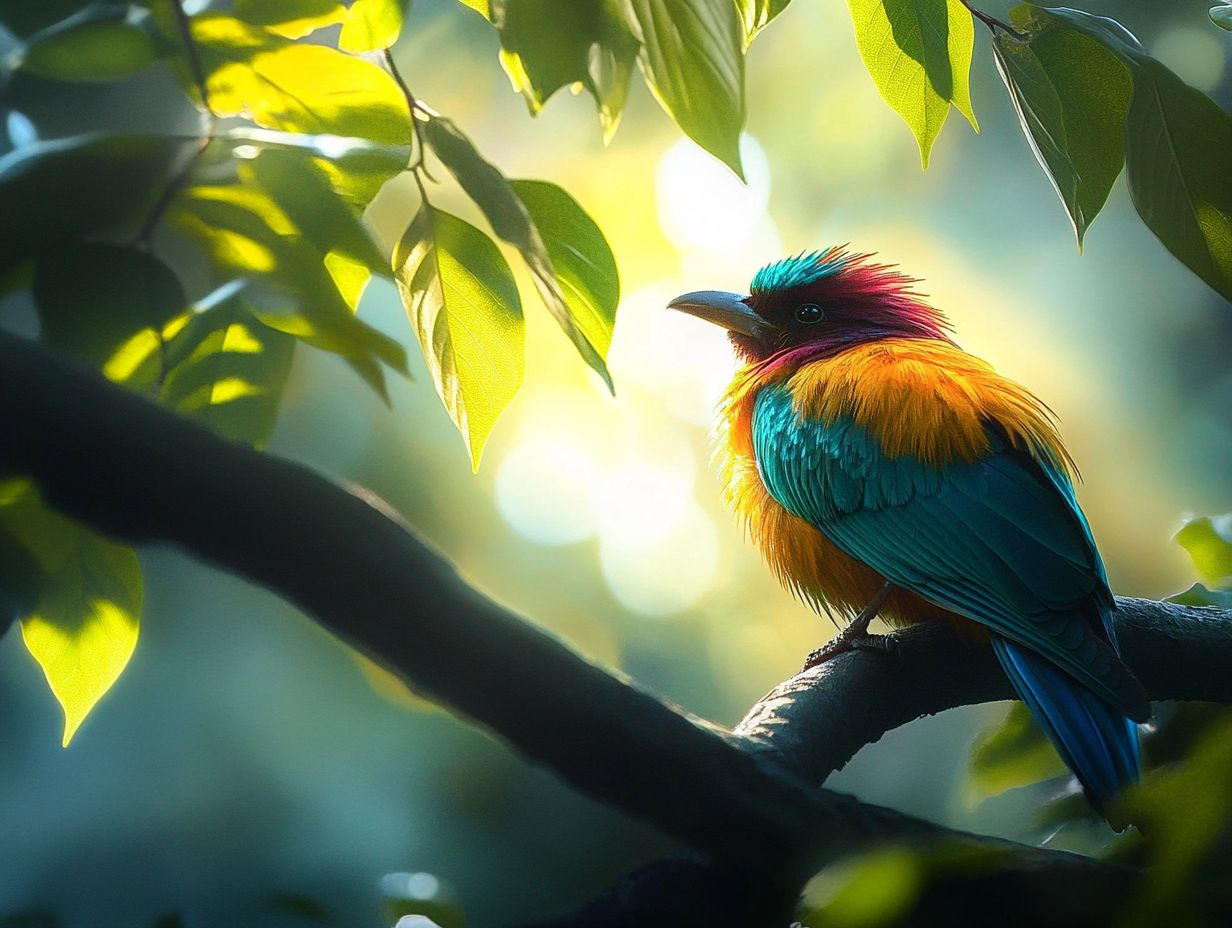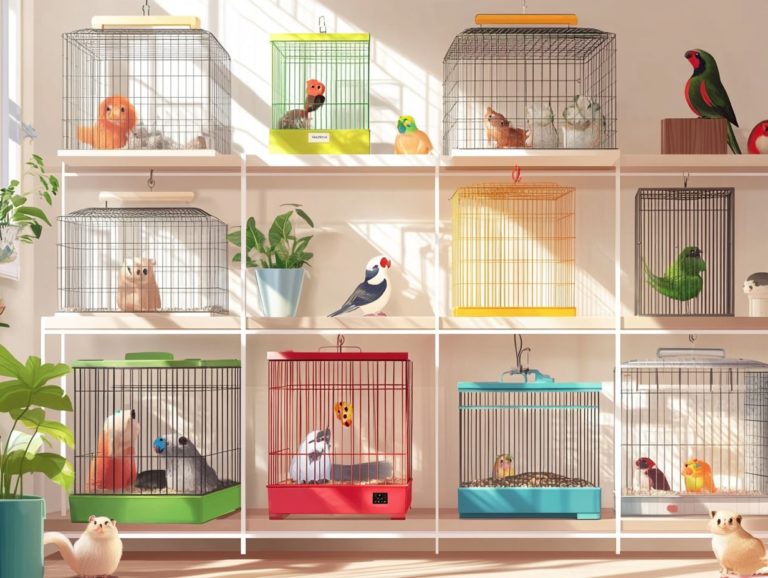Understanding Lighting Needs for Birds
Get the right lighting to keep your feathered companions happy and healthy! Proper lighting significantly impacts their mood, behavior, and overall health, making it crucial for pet care.
This article explores the vital role of lighting for birds, focusing on the differences between natural sunlight and various types of artificial lighting, such as standard LED and special bird lamps. Discover key factors for selecting the appropriate lighting for different species and learn how to spot signs of insufficient lighting.
Find practical tips to create the best lighting for your birds, including advice on lamp placement and using full-spectrum lighting to mimic natural sunlight.
Contents
Key Takeaways:

- Proper lighting is crucial for birds’ health and well-being, affecting their behavior, mood, and physical condition.
- A combination of natural and artificial lighting is ideal, so incorporate effective lighting systems that cater to various species’ needs.
- When choosing lighting, consider the species, their specific preferences, and proper placement to emulate their natural environment.
The Importance of Proper Lighting for Birds
Proper lighting is essential for your birds, especially if they are pets or housed in an aviary. Specialized lighting like Aviary Bird Light can be crucial for their well-being. Birds need the right spectrum of light to mimic natural sunlight, which is vital for Vitamin D absorption, calcium metabolism, and overall welfare.
Implement effective lighting systems, including Daylight bulbs and UV-B lighting, to enhance your indoor birds’ quality of life while reducing operating costs. This is a top priority for both bird owners and lighting experts dedicated to fostering a thriving environment for their feathered friends.
Why Lighting Matters for Birds
Lighting profoundly affects birds’ physical health, behavior, and overall well-being. Many species can see four colors, giving them a unique ability that impacts their mood and social interactions. Insufficient light can lead to distress and health decline.
Natural light is especially important for regulating hormone levels that affect breeding cycles and reproductive success, crucial for parrot care and other exotic pets. Experts like John Courteney-Smith and David Alderton highlight the need to mimic natural sunlight since many birds possess this remarkable vision.
Poor lighting conditions can cause stress, anxiety, and behavioral issues in indoor birds. Thus, creating a balanced lighting environment using full-spectrum bulbs and adjusting lamp placement is vital for nurturing a healthy and thriving avian companion.
Natural vs Artificial Lighting
Understanding the differences between natural sunlight and artificial lighting, including options like LED bulbs, is essential for creating the ideal environment for birds. This knowledge is particularly important for meeting their unique lighting requirements indoors.
Don’t wait take steps today to improve your birds’ lighting and see the difference!
Pros and Cons of Each Type of Lighting

Both natural sunlight and artificial lighting have their own advantages and disadvantages, which impact your feathered friends’ welfare and energy efficiency. For instance, artificial setups often lead to higher operating costs.
Natural sunlight provides rich energy that fosters healthier behaviors and supports circadian rhythms in birds. This makes it the top choice for many avian enthusiasts. However, effective sunlight exposure often requires thoughtful window placements or outdoor aviaries, which may not be feasible for everyone, especially those with multiple indoor birds.
On the other hand, artificial lighting allows for controllable brightness and flexibility. However, it can lead to higher costs over time due to energy consumption and the need for lamp varieties and bulb replacements. Make sure the bulbs are spaced just right to keep your birds happy and healthy! Inadequate spacing can cause uneven lighting, hindering optimal growth and vitality, especially in terms of calcium absorption and overall bird health. Maintaining the ideal setup can feel cumbersome and may require frequent adjustments.
Factors to Consider When Choosing Lighting for Birds
When selecting the right lighting for birds, it s essential to consider multiple factors, including lamp placement and the specific lighting system tailored to your bird species. Think about the specific species of birds you have and the type of lighting system that will best meet their unique needs.
Bird Species and Their Lighting Needs
Different bird species, like macaws, African greys, and Lovebirds, have distinct lighting requirements that are crucial for their health and well-being. Understanding these requirements is vital for you as a bird owner.
For example, macaws thrive in bright, natural light, as they come from sun-drenched habitats. In contrast, Canary Wing BeeBee prefers more diffuse light, reflecting their native environments. African greys enjoy softer, more diffused lighting that mirrors their forest environments. Lovebirds require about 12 hours of light each day, simulating the natural day length they would experience in the wild. This needs careful attention to lamp placement for optimal results. Meanwhile, canaries need a balanced mix of light and darkness to keep their plumage vibrant and their singing melodious, achievable with the right lighting systems.
Recognizing how these birds perceive light not only supports their physical health but also enriches their behavioral patterns and moods, ultimately enhancing bird welfare in your home.
Lighting Placement and Timing
Proper lamp placement and timing of lighting exposure significantly influence the health and behavior of your indoor birds, affecting their natural day and sleep time cycles.
By positioning bird lamps thoughtfully to mimic an outdoor environment, you can create a lighting system that promotes their well-being. Adjusting the brightness and intensity of lights throughout the day helps replicate the nuances of natural sunlight and twilight, supporting their body functions. For instance, gradually increasing light in the morning signals the start of your birds’ active period, while dimming it in the evening prepares them for rest, enhancing their bird room experience.
Incorporating full-spectrum bulbs enhances visual clarity and supports natural cycles, aligning them with nature and improving their overall bird health. Recognizing the importance of lighting allows you to provide an enriched environment that fosters health and happiness for your feathered companions through informed choices in indoor lighting.
Signs of Inadequate Lighting for Birds

Recognizing signs of inadequate lighting is crucial for bird owners who want to ensure their pets’ health. Poor lighting can lead to physical and behavioral problems, making it essential to create a suitable environment for your feathered friends.
Behavioral and Physical Indicators
Behavioral and physical signs help evaluate bird health. The quality of lighting they receive directly influences their well-being.
If lighting is poor, you may notice your birds becoming lethargic. They might perch more and engage less in playful activities, which can affect their vocalizations.
Vocalizations may also decrease as birds feel less secure in a dim environment. This can disrupt their communication with flock members and lead to additional stress.
Feather condition is another vital aspect to consider. Insufficient light can impede proper molting, resulting in dull, unhealthy plumage and impacting their overall birds’ welfare. By ensuring that they are exposed to adequate lighting, including options like UV safety and full spectrum lighting, you can help improve their activity levels, restore their vocalizations, and enhance feather quality, ultimately promoting their overall well-being and vitality.
How to Provide Adequate Lighting for Birds
To ensure your birds thrive, it s vital to create a bright, healthy atmosphere for your birds! This means carefully selecting the right lighting options, including UV-B lighting a type of light that helps birds produce vitamin D and full spectrum lighting. Incorporate specialized bird lamps and commit to proper maintenance and timely lamp replacements.
Lighting Options and Tips for Optimal Setup
You have a variety of lighting options available for your feathered friends, including UV-B lighting and full spectrum lighting, as well as LED bulbs and Daylight bulbs, each offering unique benefits for their health and well-being.
When selecting the right lighting, it’s crucial to understand the specific requirements of the avian species you care for, including their lighting preferences. UV-B lighting is particularly important as it aids in the synthesis of vitamin D3, promoting better calcium absorption and supporting strong bone health, especially for species like Budgies and Macaws. Full spectrum lighting closely mimics natural sunlight, helping to regulate circadian rhythms and enhance overall mood, making it a preferred choice among bird lighting experts.
For an optimal setup, position the lamps about 12 to 24 inches away from your bird’s habitat to ensure proper exposure, particularly for indoor birds. This ensures adequate exposure without causing stress, which is especially critical for maintaining the health of pet birds in an indoor environment.
Provide a variety of light sources, including LED options and special bird lamps, to create a balanced environment that nurtures the well-being of these vibrant creatures, enhancing their quality of life and promoting their happiness.
Frequently Asked Questions

What do your birds need for the best lighting?
Birds require a balance of natural and artificial lighting, including options like Aviary Bird Light, to maintain their circadian rhythm and overall health.
Why should you care about your birds’ lighting needs?
Lighting plays a crucial role in a bird’s behavior, reproduction, and overall well-being. It can also affect their feather quality and coloration, which are essential for bird health.
Take action today! Ensure your birds have the lighting they need to thrive and feel their best.
What is the recommended lighting schedule for birds?
A typical lighting schedule for birds includes 12-14 hours of daylight and 10-12 hours of darkness. This mimics their natural environment and allows for adequate rest.
Do birds need access to sunlight?
Yes, birds need exposure to natural sunlight to meet their Vitamin D and Vitamin D3 needs. If natural sunlight is not available, they can also get it from full-spectrum artificial lighting.
How can I provide proper lighting for my pet bird?
It is recommended to use full-spectrum light bulbs specifically designed for birds. These bulbs provide a balanced spectrum of light that mimics natural sunlight and have excellent quality of light that shows colors accurately.
What are some signs that my bird is not getting enough light?
Watch out for these signs! If a bird is not getting enough light, they may show:
- Lethargy
- Poor appetite
- Decreased social interaction
- Irregular molting patterns
Inadequate lighting can affect calcium absorption and disrupt glandular systems. Consult a veterinarian if you suspect your bird’s lighting needs are not being met.
Ensure your bird enjoys the best light for a happy and healthy life!






